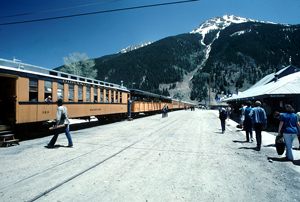 |
|
Please note: This summary is provided to help you understand the regulations. Consult the references provided for links to the full text of the regulations.
This page covers rules for locomotive idling and describes what EPA is doing to reduce emissions from this source.
Related topic: Engine Emissions (Locomotives). Who is covered by the regulations? With some limited exceptions, the regulations apply to all diesel line-haul, passenger, and switch locomotives that operate within the U.S., including newly manufactured locomotives and remanufactured locomotives that were originally manufactured after 1972. Electric locomotives, historic steam- powered locomotives, and locomotives originally manufactured before 1973 do not contribute significantly to the emissions problem, and thus, are not included in this rulemaking. In general, locomotives are remanufactured every five to fifteen years. What is the purpose of the regulations? Locomotives spend a substantial amount of time idling, during which they emit harmful pollutants, consume fuel, create noise, and increase maintenance costs. The regulations are aimed at reducing the amount of time that locomotives idle, in addition to reducing emissions during normal operations. Locomotive diesel engines contribute significantly to air pollution in many of the nation's cities and towns. Of particular concern are particulate matter (PM) and nitrogen oxides (Nox), a key precursor to ozone and secondary PM formation. These pollutants are emitted while locomotives are moving or idling. Idling often occurs within or near cities and towns. This rule is an important component of EPA's ongoing National Clean Diesel Campaign (NCDC). The most recent federal regulations affecting locomotive idling are part of the comprehensive 2008 EPA rulemaking (codified at 40 CFR Part 1033) that reduce emissions from locomotives. In this rulemaking EPA adopted new requirements to reduce emissions from idling locomotives by requiring technology that reduces the amount of time a locomotive spends idling and applying tighter emission standards to new locomotives generally. EPA's regulatory efforts to reduce emissions from idling locomotives focus on requiring the application of automatic idle reduction technologies to the locomotives themselves rather than directly regulating when railroads may allow locomotives to idle. The new rule requires that idle controls, such as Automatic Engine Stop/Start Systems (AESS), be included on all newly-built Tier 3 and Tier 4 locomotives. The rule also applies to all existing locomotives that are subject to the new remanufactured engine standards, at the point of first remanufacture under the standards, unless they already equipped with idle controls. Locomotives equipped with an AESS device under this program must shut down the locomotive engine after no more than 30 continuous minutes of idling, and be able to stop and start the engine at least six times per day without causing engine damage or other serious problems. Continued idling is allowed under the following conditions: to prevent engine damage such as damage caused by coolant freezing to maintain air pressure for brakes or starter systems to recharge the locomotive battery
In addition to requiring use of specific idling control equipment, the 2008 standards also require most existing locomotives be retrofitted with emissions controls when they are remanufactured that reduce emissions whenever the locomotive is operating. By requiring overall reductions in emissions, the requirements have led to locomotive exhaust being cleaner when a locomotive is idling. Switchyard locomotives (or switchers) move rail cars around a rail yard. Of the 20,000 large-scale locomotive engines currently in operation, 5,000 are estimated to be switchers. Due to the nature of their work, switchers are left idling at a much greater percentage of their operating time than line-haul locomotives. New idle control technologies have been developed to reduce switcher idling without loss to productivity. These products typically operate by automatically shutting down an engine based on temperature or a pre-set time period. These products can also provide engine warmth in cold weather through the use of a smaller auxiliary engine or an electrical connection. The cost of idle control technology is generally in the range of $27,000 to $40,000. In most cases, this cost is offset by fuel savings in less than two years. For a list of vendors and more detailed product information, get in touch with EPA's SmartWay program: https://archive.epa.gov/midwestcleandiesel/web/pdf/switchers2.pdf EPA Finalizes More Stringent Emissions Standards for Locomotives and Marine Compression-Ignition Engines. EPA fact sheet. EPA's Office of Transportation and Air Quality (OTAQ). Rule and related documents. Learn About Idling Reduction for Locomotives. Verified Technologies for SmartWay and Clean Diesel. |
 Engine Emissions (Locomotives, Idling)
Engine Emissions (Locomotives, Idling)